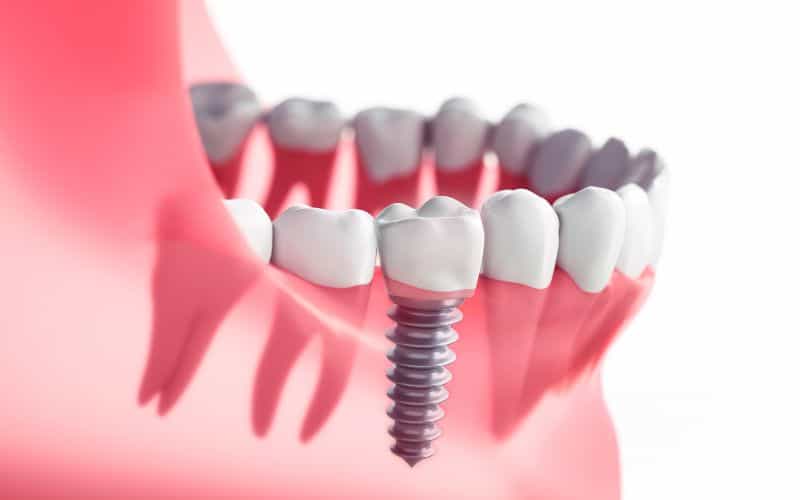Explained: How Do Dental Implants Really Work?
According to the American College of Prosthodontists, roughly 50% of the population of the US is missing at least one tooth. That means around 178 million Americans, and the number is expected to rise. Besides causing problems with eating and sometimes speaking, an incomplete smile may cause a big dent in your confidence. What if we told you dental implants offer a permanent solution? Read about dental implants, how they work, and how they are placed.
In This Article:
- What Are Dental Implants?
- How Do Dental Implants Work?
- How Are Dental Implants Placed?
- Different Types Of Dental Implants:
- How Are Dental Implants Attached To The Jaw?
- How Painful Is Getting A Dental Implant?
- How Long Do Dental Implants Last?
- Are You Interested In Getting Dental Implants?
What Are Dental Implants?
Dental implants are like artificial tooth roots that support replacement teeth. They’re made from body-friendly materials, such as titanium. Dental implants fuse with the jawbone over time through a process called osseointegration. This integration creates a strong and durable bond, much like a natural tooth root, ensuring the stability and longevity of the implant. They are a long-term (often permanent) and natural solution to missing teeth.

How Do Dental Implants Work?
A dental implant is a three-part structure, with each piece playing a distinct role. It consists of these components:
- The implant (or screw). This serves as the artificial root of the tooth. The implant is typically made of biocompatible materials like titanium. This screw-like component is carefully placed into the jawbone during a surgical procedure.
- The abutment acts as the connecting post. It’s attached to the implant after the healing period. This small connector piece protrudes above the gum line and serves as an anchor for the final restoration. The abutment allows for the secure attachment of the crown, ensuring a natural and functional fit.
- The crown is the visible part of the dental implant that resembles a tooth. Custom-made to match the shape, size, and color of your natural teeth, the crown is placed on top of the abutment. This final restoration not only completes the aesthetic appearance of your smile but also restores the functionality of the missing tooth. Dental implants offer the most natural feeling solution to the replacement of missing teeth.

Why Are They Done?
Dental implants are used to replace missing teeth. They are done for a variety of reasons, all aimed at restoring missing teeth and improving overall oral health. Some situations where dental implants are recommended:
- Tooth loss. Dental implants are an excellent option if you have lost a tooth or multiple teeth due to decay, injury, or gum disease. Implants provide a stable and long-term solution, restoring the function of the teeth and the appearance of your smile.
- Improve chewing and speaking. Missing teeth can make it challenging to chew food properly and food may get stuck. Dental implants replace the missing teeth, allowing you to enjoy a wider range of food and speak with confidence.
- Preservation of jawbone. When a tooth is lost, the underlying jawbone may deteriorate over time. Dental implants help stimulate the jawbone, preventing bone loss and maintaining its strength and shape.
- Prevent shifting of teeth. When there is a gap in your smile due to missing teeth, the neighboring teeth may start to shift or tilt, leading to misalignment. Dental implants fill the space, keeping the surrounding teeth in position.
- Support for dentures or bridges. Dental implants can be used as anchors to support removable dentures or bridges. Implants provide stability, preventing these restorations from slipping or moving.
- Improved confidence. Missing teeth can impact your self-esteem. Dental implants provide a natural-looking and permanent solution, helping you feel more comfortable and self-assured in social and professional situations.
Interesting read: The Pros and Cons of Dental Implants
How Are Dental Implants Placed?
The process of placing dental implants involves several steps that are carefully carried out to ensure a successful outcome. Of course, each situation is different, so variations may occur.
Before the implant placement, the dentist will conduct a comprehensive examination of oral health, including X-rays and scans. This evaluation helps determine the condition of the jawbone, the ideal placement location for the implant, and the type of implant suitable for the situation.
Sometimes bone preparation is necessary. When the jawbone lacks sufficient volume or density to support an implant, a bone grafting procedure may be required. This involves adding bone material to the deficient area to enhance its strength and provide a solid foundation for the implant.
When all is set, it’s time for the implant placement surgery. This is typically performed under local anesthesia to ensure your comfort throughout the procedure. Your dentist will create a small incision in the gum tissue to expose the underlying jawbone. Then, using specialized instruments, a small hole is carefully drilled into the bone to accommodate the implant.
The implant, resembling a screw, is precisely inserted into the drilled hole. The implant’s biocompatible material, often titanium, allows it to fuse with the jawbone over time in a process called osseointegration. This integration provides a strong and stable base for the future replacement tooth.
After the implant is placed, the healing process begins. It usually takes several weeks to months for a process called osseointegration to occur, during which the implant integrates with the surrounding bone. This ensures a solid and long-lasting foundation for the replacement tooth.
Once osseointegration is complete, the abutment is attached to the implant. The abutment serves as a link between the implant and the final replacement tooth or restoration.
After the gum tissue around the abutment has healed, your dentist will take impressions of your mouth to create a custom-made replacement tooth or crown. This replacement tooth is designed to match the color, shape, and size of your natural teeth, providing a seamless and aesthetically pleasing result.
Different Types Of Dental Implants:
There are various types of dental implants available, each designed to address specific tooth replacement needs.
Single-tooth implant
A single-tooth implant replaces one missing tooth. This type of implant involves placing an implant screw into the jawbone, which acts as an artificial root. A dental crown is then attached to the implant screw, creating a natural-looking and fully functional replacement tooth.
Implant-supported bridge
Implant-supported bridges are suitable when you have several missing teeth in a row. Instead of relying on natural teeth for support, these bridges utilize dental implants as anchors. The implants are strategically placed in the jawbone, and the bridge is securely attached to them, filling the gap created by multiple missing teeth. This type of implant-supported bridge has all the benefits that a single-tooth dental implant has.
Here’s a comparison to think about before getting a dental bridge or an implant. (opens in a new tab)
All-on-4 dental implants
The all-on-4 dental implant technique is recommended when there is a need to replace a full arch of teeth, whether it’s the upper, lower, or both jaws. This innovative solution uses four precisely positioned dental implants to support a full set of teeth.
3-on-6 Dental implants
The 3-on-6 dental implant option is an alternative to implant-retained dentures. It involves the placement of six dental implants, which act as anchors for three individual dental bridges. The 3-on-6 implants provide a secure and comfortable fit.
How Are Dental Implants Attached To The Jaw?
There are also variations in the way dental implants are attached to the jaw. Which one is used, depends on the health of the jaw bone.
- Endosteal implants are the most common. They are suitable for most patients who have a healthy jawbone capable of fusing with the implant post. These implants are designed as screw-shaped posts that are inserted into the jawbone. They act as sturdy placeholders onto which the false teeth can be attached.
- Subperiosteal implants offer an alternative to endosteal implants. Instead of being fixed into the jawbone, these implants rest on top of the bone but beneath the gum tissue. A metal frame is positioned under the gum, with a post attached to it. The gum then heals around the frame, securely holding it in place. The false teeth are attached to the posts that emerge from the gum. Subperiosteal implants are used when there is insufficient jawbone for an implant or when a patient prefers to avoid extensive oral surgery for bone augmentation.
- Zygomatic implants are the least common type of dental implant and are for patients that have a severe lack of jawbone for endosteal implants. In this procedure, the implant is placed in the cheekbone (zygoma) instead of the jawbone. This approach requires a highly skilled oral surgeon and is considered the most complex implant procedure. Zygomatic implants provide an alternative solution when traditional implants are not feasible due to inadequate jawbone structure.
If a dental implant doesn’t seem like the right fit for you, this article about dental implant alternatives might interest you.
How Painful Is Getting A Dental Implant?
Pain experienced during a dental implant procedure varies from person to person, but the process is typically well-managed with local anesthesia to ensure comfort. During the implant placement surgery, you should not feel any pain.
However, it is common to experience some discomfort and mild soreness in the days following the procedure. This is comparable to (or even less than) tooth extraction and can be managed with over-the-counter pain medication recommended by your dentist. Some swelling and bruising can be seen, which usually subsides within a few days.
How Long Do Dental Implants Last?
Dental implants are designed to be a long-term solution for replacing missing teeth. With proper care and maintenance, they can last for many years. In fact, in most cases, they can last a lifetime. The longevity of implants is influenced by various factors, including oral hygiene practices, overall health, lifestyle habits, and the quality of the implant materials used.
Regular dental check-ups and cleanings are crucial to ensure the health and longevity of your implants. It’s important to maintain good oral hygiene by brushing and flossing regularly and using antimicrobial mouth rinses as recommended by your dentist. Additionally, avoid habits such as smoking, sodas, and alcohol, to maximize the long-term success of dental implants.
Are You Interested In Getting Dental Implants?
If you think dental implants might be right for you or want to learn more about how they can change your life, our highly specialized dentists at Mint Dental in Edina, MN, would be happy to help.
Get in touch today at (952)831-1332.
